V. The Macclesfield Bollington and Marple Railway 1863-1910
1. Origins (1849-64)
In order to present a continuous narrative of the Midland's drive for Manchester and its effect on Marple Station, no mention has yet been made of the Marple Wharf-Macclesfield line. It is now therefore time to turn to this, the lesser of the two lines serving Marple.
It might be thought that such a line could not possibly equal the railway political significance of the line through Marple, passing through nowhere of any size but Bollington, and enjoying throughout its existence a purely local service. Far from it: the line had an origin as stormy as any, and can be added to the long list of "might-have-beens" as regards Main Line significance.
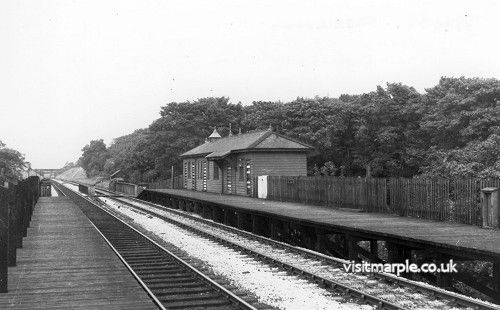
Middlewood Higher Station from the south in 1962, 2 years after closure. The platforms and Up buildings remain intact, but the small shelter on the Down side has been removed. The L.N.W. Buxton line is crossed by the bridge just north of the station. (From Marple Rail Trails)
The ogre of the piece was, as usual, the L.N.W., ever jealous, ever obstructive. The origins of the line can be traced back to 1849 when the North Staffordshire Railway (N.S.), having reached Macclesfield, found the way to Manchester blocked by the L.N.W., and proposed a branch to Whaley Bridge to join the proposed M.S.L. branch from Hyde Junction. Nothing came of this, but the N.S. continued to find the L.N.W. obstructive, and refusing to allow any traffic to Manchester to pass via Macclesfield, insisting it went via Crewe, thus ensuring a higher L.N.W. mileage.
In 1863 Thomas Oliver, a Macclesfield businessman, promoted a scheme for a local line from Macclesfield to Marple via Bollington - the Macclesfield, Bollington and Marple Railway (M.B.M.). It was particularly hoped to revive Bollington, then an important cotton town, but suffering from depression due to the American Civil War, and that Kerridge Stone from local quarries would be a valuable traffic; the collieries of the Poynton area were also expected to provide much revenue. The N.S. seized on this scheme, seeing in it a route to Manchester independent of the L.N.W., which was being particularly obstructive at that time. When the promoters approached the M.S.L. General Manager, Edward Watkin, he was enthusiastically in favour, seeing in the line another outlet for the M.S.L. to the south, and the start of a possible independent extension to London. In fact the Macclesfield Courier and Herald went so far as to proclaim Watkin the inspiring light of the scheme, second only to Thomas Oliver. With such support, the scheme prospered, though the L.N.W. only withheld opposition on the condition that the M.S.L. withdrew their support from various schemes west of Macclesfield. The line was therefore authorised on 14 July 1864, with the M.S.L. and N.S. empowered to subscribe £80,000 each for its construction, and work and maintain it when open. But almost immediately the original purpose of the line - to provide the N.S. with an independent route to Manchester - was lost, as the L.N.W., in consternation at the success of the M.B.M., came to an amicable traffic agreement with the N.S.
2. Construction and Opening (1865-73)
The urgency had thus gone out of the scheme, and construction was very slow, despite there being no substantial engineering works, apart from a low 23 arch viaduct at Bollington, and deep cuttings approaching Marple Wharf Junction. The slowing down was also due to the general trade depression of the mid 1860's. In 1868 the N.S. board was considering means of disposing of the remaining £40,000 of unsold shares, and by June of the same year only £93,165 had been spent of the eventual cost of £187,079.
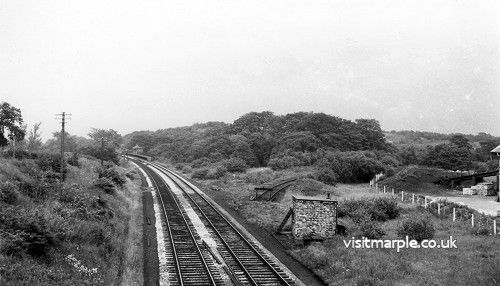
Site of the Middlewood Curve from High Level Junction in 1962. Part of the curve, closed in 1955, remains as a siding from Low Level Junction. Middlewood Higher Station is visible in the distance.
However, the line eventually opened on 2 August 1869 for passengers only; the line was single throughout, with the track on the Up side, though the formation was wide enough for double; single platform stations were provided at Marple (Rose Hill), High Lane, "Poynton" and Bollington. The initial train service consisted of 4 trains each way between Macclesfield and Romiley, where trains terminated for some while until the service was extended to London Road; there were two services each way on Sundays. Goods traffic began on 1 March 1870, and Goods Depots opened at Rose Hill and Bollington. In 1871 the line was doubled throughout at a cost of £16,000, and second platforms were provided at the stations. By 1872 a connection had been opened at Poynton to Lord Vernon's extensive colliery railway system; the line left the Main Line by a south facing connection just north of the station platform, and swept round in a wide circle, to enter the colliery to the west. Much traffic passed from this system on to the M.B.M. until the last colliery closed in 1935.
The line in 1871 was vested in the N.S. and M.S.L., as the "Macclesfield Committee Railway", with a board of 8, with 4 directors from each company. The M.S.L. ran the trains and provided staff, but the N.S. Civil Engineer was responsible for engineering work and maintenance, though the M.S.L. agreed to provide a steam crane for bridge work.
The original terminus of the line was a temporary affair in Macclesfield, near the L.N.W. Hibel Road Station. For 2 years Watkin tried to persuade the L.N.W. to join the N.S. and M.S.L. in the construction of a tripartite joint station, but the L.N.W. refused to consider this, fearing lest a single passenger should escape their net and travel on the new line. So the N.S. and M.S.L. went ahead without the L.N.W., and built a link from the M.B.M. to join the N.S. main line about a quarter of a mile south of Hibel Road Station. A new joint M.S.L.-N.S. joint station was opened in 1873, and the original terminus turned over to goods; the new station was called "Central", and was certainly more conveniently situated than Hibel Road. But the potential of the Central station was never realised, as the L.N.W. refused to permit any through N.S. - L.N.W. trains to use the joint station, and so the best trains called at Hibel Road only, thus depriving Central Station and the M.B.M. of much of its connectional usefulness.
The line once more became a pawn in railway politics when in 1876 the M.S.L. and N.S. came within an ace of amalgamating; had they done so the M.B.M. would have probably become a link in the M.S.L.'s route to London, of which Watkin dreamed. This all however came to nothing and the line settled down to a purely local existence.
Seal of the Macclesfield, Bollington & Marple Railway (British Railways)
3. The Middlewood Curve (1876-85)
In 1879 a station was opened at Middlewood where the M.B.M. crossed the L.N.W. Stockport-Buxton line and almost directly above the L.N.W. Middlewood Station for the purpose of inter-change of passengers. To provide better facilities between Macclesfield and Buxton, a curve connecting the two lines at Middlewood was suggested in 1876, but did not materialise until 1885. The curve was laid out on generous lines with a flyover carrying the Down line from Macclesfield over the Buxton line to join the Up line to Buxton, thus avoiding conflictions with Down Buxton trains. Such an arrangement was very elaborate, and normally only found at the most important and busiest of junctions: it is in fact the only such "flying" junction on the south side of Manchester: the promoters of the scheme must have had high hopes of its success.
The first trains, probably excursions ran on Whit Monday, 25th May 1885, and regular services between Macclesfield and Buxton began the next day; a through Stoke-on-Trent to Buxton service followed later that year. But the curve was not a great success, and soon services were confined to the summer months. Trains were always provided during July and August, and sometimes in May, June, or September, or any combination of these months, usually on Saturdays only, though some trains operated on Mondays, Tuesdays and Wednesdays as well. In the summer of 1896 for instance all the five Saturday, and three weekday trains started from Macclesfield only, but one or two conveyed through coaches to and from Stoke; all called at Bollington, and the odd one at Poynton as well.
The N.S. tried to induce the L.N.W. to run a through London-Buxton service by this route to compete with the Midland, but the L.N.W. said that it was not practicable as "the through coaches had to be taken by a reverse journey between the two stations in that town (i.e. Macclesfield) - not a very satisfactory movement in any competitive through route". What the L.N.W. ignored was that if they had agreed to use Central as their Macclesfield Station, no such reverse move was necessary.
Through goods trains did however regularly use the curve, and three exchange sidings were laid, and later a siding to serve an adjacent clay pit was added. There was a daily early morning goods from Macclesfield to Buxton known as the "Knotty"; it was so named after the nickname of the N.S. which used the Staffordshire knot as its company badge. This ran until after World War 2, but when it ceased the curve was mainly used for storing old coaches.
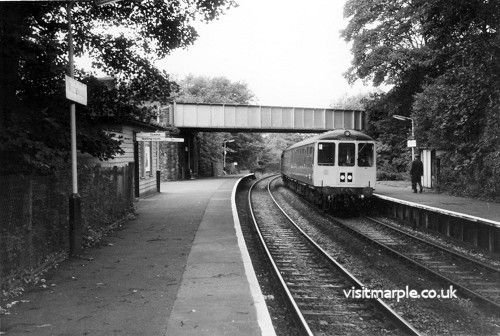
A Scene of silvan tranquillity broken by the arrival of the 9.35 Manchester-Whaley Bridge d.m.u. at Middlewood (Low Level) on 12th September 1978. The overbridge formerly carried the Marple Wharf Junction-Macclesfield line, and the High Level Station was just to the left. (Author)
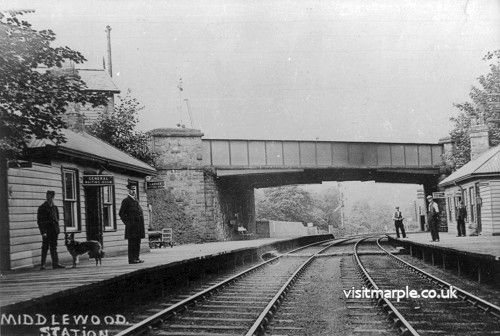
Middlewood Low Level Station from the East c1910. Note the frock coated Station Master, the up buildings and the signals of the High Level Station visible on the left. (F. Hawley).
4. Description of the Line
The line diverges from the Manchester-Marple main line at Marple Wharf Junction, which was, as we have seen, a Junction for the Canal Wharf branch before the Macclesfield line was even conceived. The line immediately on leaving the main line begins rising, and curves round a full 90 degrees, necessitating a very low speed for trains negotiating the branch, which would have been a serious impediment to use of the line as an express route to London. Such a sharp curve is however necessary to make the M.B.M. line coming up from the south meet the main line, without the need for a separate viaduct over the Goyt on the one hand or, on the other, a tunnel under the high ground on which Marple lies. As it is, the M.B.M. only joins the main line on the brink of the viaduct, and the cutting leading up to the junction is deep enough as it is. In fact the cuttings between Marple Wharf and Rose Hill gave considerable trouble, and collapsed in one place in the vicinity of Clifton Drive, due to one of the numerous pockets of sand in the geology; accordingly the railway bought a strip of land all along the east side of the line to prevent anybody building on it, and claiming compensation if the bank collapsed; most of this land is now rented out, but still in railway hands. The railway skirts the hilly ground of Marple, until emerging into flatter terrain at Rose Hill, whence it skirts the base of the Pennine range all the way to Macclesfield. At Rose Hill the main Stockport road was diverted over the line by a large hump-back bridge, thus accounting for the kink in the road at this point. The original single line station buildings at Rose Hill were on the Up, or Macclesfield side, and were of the small unpretentious M.B.M. style found at all the other stations on the line: a small one storey brick building, with a low pitched slate roof, extended out on beams and brackets to form an elementary canopy. The accommodation consisted of four rooms all entered from the platform - a Porters Room, at the north, followed by the Station Office, with a booking window to the adjoining General Waiting Room-cu m-Booking Office; a Ladies Room with lavatories completed the facilities, with a brick-built Gents adjoining. The only architectural feature was a small square bay, with clock, projecting from the Station Office, whence the Station Master could survey his domain. The Down platform probably originally had a rudimentary wooden shelter, similar to those which survived at other stations on the line. But the growing business at Rose Hill, particularly residential traffic to Manchester, called for greater facilities, which were probably provided in c.1880, in the form of a brick-built block on the Down side. This had a flat wooden canopy supported on cast iron brackets towards the Platform and comprised a Ladies Waiting Room, with a lavatory, and a General Waiting Room. Later on as the Manchester bound business grew, a second Booking Office was provided by tacking a lean-to wooden office onto the General Room, with a booking window into the latter. This second Booking Office was generally only open when a Down train was due, but survived in use until 1970. Incidentally the Down Ladies Room contained a Waiting Room bench with the initials "M.B.M." carved on the backrest. This was still in situ up to 1970, but was then purchased and is now in private hands. The station would have probably been originally oil lit, but gas lighting had arrived by the turn of the century. Then, as now, there was no footbridge, access being by individual pathways from the main road, with a sleeper crossing for staff use. Originally the Signal Box was probably on the Up platform, in the recess with a stone retaining wall on three sides, still visible today, albeit filled up. However it was later found expedient to place the Signal Box nearer the points into the goods yard, just south of the Down platform.
The goods yard initially consisted of a single siding running behind the present Down buildings, and terminating beside a loading bay. To the south three sidings served Tym's Rose Hill Brickworks, which remained open until the 1920's. The site later became the Marple Urban District Council Depot, and they too had a private siding and loading bay until the 1960's. In c.1900 the goods yard was extended by the addition of a second siding to deal with the growing coal traffic, and a weighbridge provided near the road entrance. At the same time the N.S. rebuilt the Signal Box on much the same site, and this box lasted until 1970; it was the most northerly N.S. style signal box. The mainstay of the goods traffic at Rose Hill was always coal, though there was some agricultural traffic. Both full wagon loads and "sundries" were dealt with, the latter being the term used for general merchandise conveyed in less than wagonloads. Marple was however always the principal goods depot for such traffic with its superior facilities of goods shed and crane.
To the south of the station, Park and Paterson in 1914 established a non-ferrous metal foundry on the site of another disused brickworks; the works was soon provided with a private siding, also closed after World War 2.
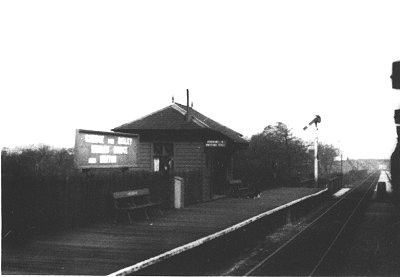
Middlewood Higher Down Platform, looking north from a train bound for Macclesfield Central, on 18th April 1954. Notice the tiny Booking and Waiting Hall, and the station sign advising passengers to "Change for Disley, Whaley Bridge and Buxton" (H.C. Casserley).
When Rose Hill was built there was not a house in sight apart from the "Railway Inn", and the station was named after the nearby Rose Hill House, which stood where The Drive now runs. Development around the station itself came after the 1st World War, but after the opening of Rose Hill, houses began to be built more on the Rose Hill side of Marple and building began to creep down Stockport Road towards the station and on to the fields on Cross Lane and Bowden Lane. A pair of houses were even built next to the station. But a passenger before the 1st World War, arriving at Rose Hill, thinking from the timetable that it was in Marple, would have been somewhat surprised to find it set amid fields and quite some way from the village: a surprise no doubt matched by the stranger who arrived at Marple station, and was confronted unawares by Brabyns Brow. From Rose Hill the line ran southward through undulating countryside, with alternate low embankment and shallow cutting, with stone road over-bridges, some under-bridges and one unmanned level crossing just south of Rose Hill.
High Lane station was equally in the middle of nowhere as Rose Hill, except that it was on the Stockport. -Buxton turnpike road; it took its name from the small settlement about half a mile away. Unlike Rose Hill it was never surrounded by much building, and remains encircled by fields to this day, The original buildings here, as at Rose Hill, were on the Up side, and had identical accommodation, except that the rooms were in reverse order, with the addition of a brick outhouse for the storage of coal at the north. The Down platform had a small wooden building, with a glass fronted waiting room, heated by a coke stove in the centre. To the south of this was a tiny second booking office, as at Rose Hill, to supplement that on the Up. Also as at Rose Hill, inclined paths connected platforms to road, and there was no footbridge only a sleeper crossing at the south end. There was a signal box at the north end of the Up platform controlling a crossover and Up and Down line signals; it is not known when this closed, but it was probably as early as the 1930's. Such modernities as gas lighting never reached High Lane, which remained oil lit into the 70's (1970's that is!). High Lane like Poynton never had a goods depot, but dealt with parcels by passenger train, and such general merchandise "sundries" as could be manhandled out of wagons onto the platform; the 1956 Railway Clearing House Handbook of Stations indicates that packages of up to 1 cwt. could be dealt with, but this facility probably ceased soon after. There would almost certainly be an arrangement with a local haulier to deliver such traffic as and when required. Station staff would consist of Station Master, 2 Signalmen, 2 Booking Clerks and 2 or 3 Porters.
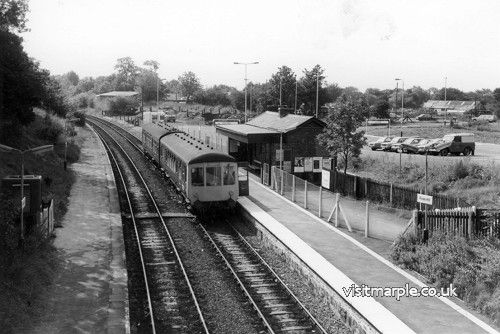
Rose Hill Station, with recently completed car park on the site of the goods yard, and the small coal yard beyond. 11th September 1978 (Author). The Rose Hill branch has since been singled.
Just over half a mile to the south lie the two Middlewood stations; here no houses, and very little at all, in fact, could be seen from the station, which as its name suggests lies deep in the middle of a wood. The station had no road access, but was served by 3 footpaths which disappeared from a variety of wicket gates on the platforms into the depths of the encompassing wood. The stranger might be surprised at the rural nature of the surroundings on arriving at Rose Hill or High Lane but at Middlewood he had every right to wonder where on earth he had got to, especially if it was a dark windy night. There was little local traffic, but the stations were quite busy with passengers changing from one line to another, for which purpose staircases connected the L.N.W. Low Level and Macclesfield Committee High Level station platforms; one staircase connected up High Level and down Low Level platforms while a footbridge crossed from High Level down platform to link up with a ramp to the up Low Level platform; the Low Level station also had the refinement of a footbridge: one feels that the link up could have been much simpler. The stations were designed to provide interchange for passengers between e.g. Macclesfield and Buxton, but to the chagrin of the M.S.L. and N.S. many of the passengers using the station were transferring from their trains from Bollington and Poynton to use the quicker L.N.W. route to Stockport and Manchester!
The Low Level station had standard L.N.W. type buildings of the mid 1870's, entirely wooden, with horizontal timbering and a low pitched slate roof. On the Up platform, were a Ladies Waiting Room and W.C., General Waiting Room and Ticket Office, plus a Gentleman's Lavatory; the same facilities were provided on the Down, minus the Ticket Office. Gas lighting never came to Middlewood, and the Low Level station remained oil lit as late as 1972. when electricity arrived. A signal box with the title "Middlewood Low Level Junction" stood at the divergence of the curve, some yards to the east. The High Level station was set high on an embankment, and was entirely constructed of wood, set on stilts in the bank, with the result that it shook alarmingly in the wind. The buildings were rudimentary: the waiting shelter on the Down was open to the elements and due to the exposed situation of the station it used to drift up with snow so that it was impossible to get into the little office adjoining. This Booking Office was so tiny that it proved a furnace to work in when the coke stove was lit, and once in, to get any working surface it was necessary to lower a folding table flap, which blocked the door! The Up platform had a larger building containing a Waiting Room adjoining the Ticket Office, Ladies Room, Porters Room, and Ladies and Gentlemen's toilets, which were of the chemical variety. Middlewood being without sanitation, the embankment was liberally manured with the contents of these. The Macclesfield Committee accommodated their Station Master in a house beside the station, and this is still standing. In the early days at least there were 2 signal boxes, one at High Level Junction where the curve diverged, and another controlling a crossover north of the station, though the latter closed at an unknown date, probably early this century.
At High Level Junction, a small brickworks developed in the early years of this century, where the clay pit had previously been. It possessed quite a set of sidings, but these closed in the 1950's. And so the line continues its uneventful way on to Higher Poynton, Bollington and Macclesfield - but outside our chosen area.
5. Train Services
The initial train service of four each way and 2 on Sundays was soon found inadequate, and in Bradshaw for October 1875 this had risen to 6 each (7 on Saturdays) and 4 on Sundays. All the Sunday services ran through to or from London Road, though of the weekday trains one Down terminated at Romiley, and one service ran to Hyde, returning from Woodley. Of the 6 London Road trains each way, half were routed via Guide Bridge and half via Bredbury; the latter had some pretensions to the title of express, as they omitted most of the intermediate stops: the 9.10 a.m. from Macclesfield ran non-stop from Romiley reaching Manchester at 9.55 a.m., and the 4.20 p.m. from Manchester, nonstop from Ardwick, reached Rose Hill in 18 minutes, and Macclesfield in 45 minutes - which is much faster than anything on offer to Rose Hill in 1980. The 5.30 and 6.30 p.m. ex Manchester trains were almost equally fast. It would appear that the M.S.L., who ran the passenger service (the N.S. ran the goods) was out to try and capture some of the Manchester-Macclesfield traffic from the L.N.W. In these early days, 4 wheeled coaches and tank engines would have maintained the service, all provided from the M.S.L. carriage sidings and loco shed at Gorton.
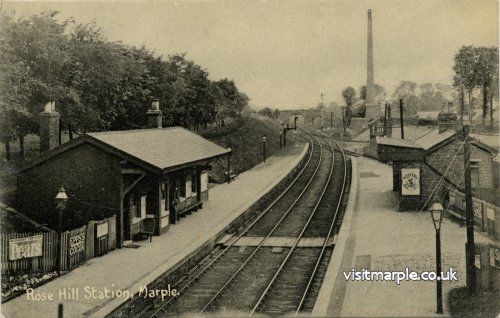
Rose Hill Station c. 1914, looking South. Note the chimney of the rail served Tym's brickworks
By August 1887, Bradshaw shows a service substantially unaltered, with 7 trains to London Road on the Down, and on the Up 6 trains from London Road, and one starting from Woodley. In addition on Saturdays a late evening train ran each way between Macclesfield and Woodley, with connections at the latter to and from Manchester. Also on Saturdays, a train ran at 1.30 p.m. from London Road, to cater for workers, who in those days worked half day on Saturdays, returning home, and for half day trippers from Manchester seeking the countryside. Between Rose Hill and Macclesfield most trains called at all stations, though one or two did not call at Middlewood, and others only called by request. There was also now a shuttle service of 3 trains each way between Bollington and Macclesfield.
Eleven years later in August 1898, the service was little altered, though all trains now called at Middlewood; most services were now routed via Bredbury, but called at most or all stations. Most "express" running had thus been given up by the M.S.L., and services wisely concentrated on intermediate traffic, with the result that timings were slower. and most trains took about an hour to reach Macclesfield; on the Manchester-Rose Hill run the fastest Up timing was 24 minutes, 23 minutes on the Down - still comparing favourably with 1980. The Macclesfield-Bollington shuttle had meanwhile risen to 5 trains each way, with 8 on Saturdays. An interesting feature of this high summer timetable were 2 early afternoon Saturday only trains from London Road, and another from Guide Bridge, with corresponding evening return trains, to cater for day trippers on their Saturday half day. Such was the number of these trippers that 2 of the trains were 3rd Class only, and were really excursion trains. By then Macclesfield trains would almost certainly consist of mainly 6 wheeled coaches, though 4 wheelers were still in evidence. Compartment stock without corridors was the order of the day, and lavatories unheard of, except in the 1st Class coaches - hence the generous provisions of lavatories at stations. Superannuated ex-Main Line M.S.L. 240 tender engines were much in evidence, as well as some of the 24-2 tanks built specifically for local work. Goods train would almost certainly be worked by antique standard goods 0-6-0's, which would operate on the "Knotty" Macclesfield-Buxton trip, and on the daily all stations pick-up, the "Woodley Goods", which ran from Macclesfield to Woodley and probably Guide Bridge; the line was also used by through M.S.L. and N.S. goods trains to the Potteries.
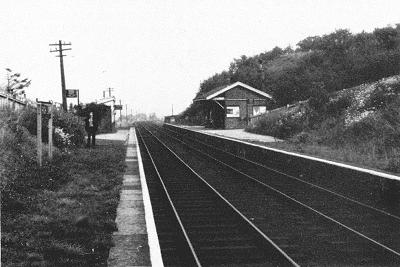
High Lane Station from the South in August 1968. The Up Buildings (right) were almost identical to Rose Hill. The Down Buildings (left) comprised a waiting room and tiny booking office. (I.R. Smith)
By Bradshaw April 1910, the passenger service had grown to 9 each way on weekdays and 10 on Saturdays, though 2 trains each way used Hyde or Woodley as their terminus. A significant feature is however, the appearance of the first morning "commuter" train, leaving Macclesfield at 7.40 a.m., Rose Hill at 8.4 a.m., to arrive at London Road at 8.53 a.m. in time for a 9 a.m. start in the office; this indicates that residential traffic was just beginning to build up; but at this point, well into the 20th C., and well out of chronological sequence, we must leave the backwater of the M.B.M. and return to Marple on the Main Line, about to witness its palmiest days.



